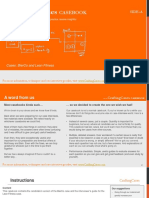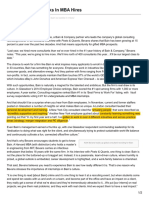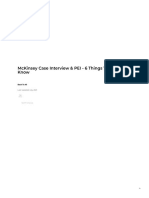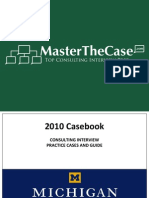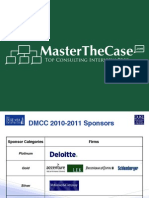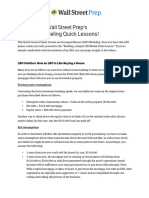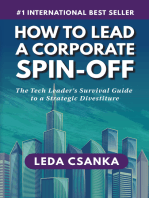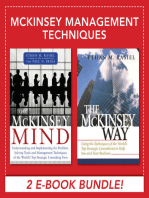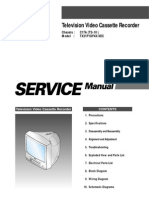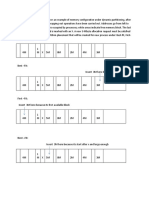Case in Point - Notes
Case in Point - Notes
Uploaded by
Lancy YangCopyright:
Available Formats
Case in Point - Notes
Case in Point - Notes
Uploaded by
Lancy YangCopyright
Available Formats
Share this document
Did you find this document useful?
Is this content inappropriate?
Copyright:
Available Formats
Case in Point - Notes
Case in Point - Notes
Uploaded by
Lancy YangCopyright:
Available Formats
Case In Point Reading Notes 1.
Mexican Bank (Industry: bank, type: profitability) Two types of banking revenue: interest income, fees (p.g 70). Decreasing average revenue/customer vs. constant average cost/customer. Due to incentive system encouraging branch manager to acquire more clients (the newer clients are not as profitable as older clients). Also had to increase # of tellers and # of branches to serve new customer. Soln: segment by customer tiers. Offer more profitable customer more access to expensive service channels and customized products. Offer less profitable customer cost-effective service channels like ATM and online services. 2. Yellowstuff (Industry: manufacturing, type business strategy) - sales are decreasing, industry decline, wants to enter a new market that s more profitable. How to identify the right markets? First, what is the target growth rate (10 percent?) How much risk is the company willing to take? What type of synergy can it leverage? Similar customer base? Strong brand/quality? Expertise in B2B? strong distribution channel? Strong sales force? Strong supply chain? What are the BTE? - regulations? FDA, EPA? Patents? Oligopoly (like Coke & Pepsi)? Long investment (green energy, R&D), limited raw material and supply (oil & gas) What are the growth trends? Is the market growing or shrinking? Are competitors entering or leaving? How much market activity? A lot of M&A? What are the exit strategy Soln: Identify the relevant industries, analyze synergy + growth patterns, and figure out how to enter (acquisition? Parternship? Start from scratch). Would it be better than just investing the money in stock market (better return, and a lot more liquid) 3. Eastern Training Network (Industry: services, type: business trategy competitive responses) Problem: IBM is entering its segment of market, what should it do? The objective is to keep it out or to maintain as much of an market share as possible. Are there any other firms in the area? What is our market share? What are other clients doing to protect its market share? Strategy (1) defensive - protect what s mine, keep IBM out (2) offensive acquire new customers, steal IBM s clients Defensive (protect what s mine) increase switching cost, create loyalty programs, long-term contracts (use incentive system to get SF to re-sign client and lock them into long-term programs) Strategy (2) raise BTE limit the supply? Use regulations? Patent? Make monopoly? NONE.
Strategy (3) go after more customers marketing efforts (ads, conventions, PR events) lobby for state contracts, steal sales staff and customer from my competition, grow through acquisitions. Differentiate the services. Do not use price wars 4. Coke (retail/consumer goods, profitability, supply/demand, price elasticity) Problem: coke is trying to become more profitable domestically by raising their prices. Volume is high and margins are low. What are the economics of raising prices and is this a good idea. Structure: revenue, costs, competitive response Revenue price, volume Costs not relevant Competitors market share (not relevant) Sales 100m cans at 23 cents each, so that 23m dollars in sales annually. If they raise prices by 5 cents, growth is 1%, if they don t raise prices, growth is 6%. So two options: (1) stay the same or (2) raise prices by 4 cents Next years revenue = next years volume * next years price (1) 100m (1.06) * 0.23 = 106m * 0.23 = 10.6 * 2 + 1.06 *3 = 21.2m + 3.18m = 24.38m = 25m (2) 100m (1.01) * 0.27 = 101m * 0.27 = 101m/4 + 1.01*2 = 25.25m + 2.02 = 27.27m Implications: So by raising prices you will make more sales about 3m more which is about 12.5%. However you will lose market share by 5m which is 2.3%. Coke decides to do a marketing campaign to maintain market share. Competitive Response is 3 options: (1) raise prices to match, (2) stay at the same price (3) lower prices. Coke will draw customer into the store, and at point of sales, Pepsi can entice customers with lower price (depends on if the customers are price conscious and sensitive). If they lower its prices, it maybe able to get even more market share. To determine if how competitor should respond, you should run numbers for the 3 scenarios and let the numbers talk. How many cans of Pepsi can be sold under each scenario. Starts with 80m at 0.23 cents a piece.
5. Road Chemical Compound (market size, new product pricing, break even analysis business strategy, political issues) Company developed a compound that extends the life of highways. Currently, government must replace highway every 5 years. If treated with this chemical, life of highway is extended to 20 years. Currently the government spends $1k/mile to replace the roads. The cost of the chemical is $50/mile.
Problems: estimate # of miles of state and federal highway in the US. How should they price the product. Other business issue? # of miles of highway = # of major highway * average length Segment to coast to coast and North to South: Coast to coast average length is 3k miles, N2S is 2k miles. Each segment has 10 hwys. So 3k*10 + 2k*10= 50k miles . Structures: cost-based pricing, price-based costing, and Willingness-to-pay. CBP: cost is $50/mile, if we use an 100% markup, we price at $100/mile. We can look at competitive pricing but there s no competitors so no PBC. We can substitute pricing (WTP): $1k/miles every 5 years, over 20 years, we are looking at $4k/mile. If we have 50k miles of highway, we are looking at $200m over 20 years. At our cost, w e are looking at 50k miles * $50/mile = 2500k = 2.5 m. So the range we are looking at is $2.5m to $200m. Other business issues: - this product reduces government labour force, there will be construction lobbying and labour union unrest. Reduced construction means higher unemployment and welfare payments. So in order to sell, it must be priced so that the government will look fiscally responsible if they choose this over the existing process. If we charge them $100m, they are saving $100m which can be used for other infrastructure projects so no one gets laid off. Price per mile = $100m/50k miles = $100 000/50 = $2000/mile $100m over a period of 2-3 years.
6. Never out Lightbulbs (New product pricing) Problem: how to price a lightbulb that never burns out Structure price-based costing, cost-based pricing, WTP (substitutes, existing payment) No competitors Costs: fixed R&D: $20m, unit cost of production: $5 Substitute prices: $0.75 to consumer, $0.5 to store, $0.25 to distributor, cost of manufacture is 0.05. CPB: Conventional bulb pricing based on cost is 5x markup on cost of manufacuture which means $25 for us to sell to distributor, then $50 to store, $75 to consumer. No one will buy a bulb for $75 so no. Other method is to check WTP: a bulb that lasts one year vs. a bulb that last 50 years. Then 50 * 0.75 = $37.50. Cannibalizing: for every eternal light bulb we sale, that s 50 or 75 conventional lightbulb we won t sell. Selling to consumer market is not good business, but selling to commercial and
industrial markets. For example, city of Cambridge has 2k street lamps. They cost $20 in bulbs and a lot more in labour like $150/bulb in labour. (two union workers, a truck driver, insurance).
7. Dupont (new product market size, business strategy, p. 84) Problem: Dupond has invented a material that would be perfect for diapers. How do they take advantage of this invention? How do they make a profit? Structure: market size, growth, profits, entry methods Diaper market size: There s 280m Americans and avg life expectancy of 80 years. The number of people is evenly distributed so the same number of people in each age group. Same # of 73 year old vs 3 year old. There s approximately 4 million in each age group. And let s say kids under 3 wears diapers. So that 12m kids who wear diapers. Let s say they each use 3 diapers a day which means there s 36m diapers used each day. A year that would be 365 * 36 m = 360 * 40m = 14400m = 14.4b diapers a year. If each diaper is $1 then that s a $14.4b market. Pricing differentials competitive landscape, marketshare, major players, small players Way of entering: start a own company, joint venture, buy a smaller player, or license the technology. Start a own company name recognition (does it translate over to a different industry? Set up manufacturing plant, hire a management team, marketing team, sales force team, establish distribution channel. Time consuming & expensive, but doable Second we can for a JV with an established company. The pros: don t have to establish name recognition, management/marketing team, salesforce, distribution channels. Cons: limiting to our profit since we are manufacturing and only able to sell to one outlet (our JV partner) 3. Acquire a small player pros: same as JV cons: do we want to integrate two organization, capital expenditure, risk of merger, do we want to manufacture or manufacture and market? 4. License product to a variety of company. Pros: don t have to do too much other than figuring out licensing fee structure, can sell to a variety of companies and have them fight each other. Solution: manufacture and license the rights, become an OEM supplier and do just the manufacturing of material. One step further would be go to different diaper companies and get pre-orders to ensure that the market is there and our pricing is in line.
8. Opera (growth strategy, market sizing) Problem: NYC Opera wants to develop a growth strategy for the next 5 years. What should they look at and what would be your recommendations?
Structure: what is they growth target (percentage), current industry growth rates, our growth rates, competitor growth rates, revenue streams (customers, products, regions, solutions), other markets to enter? Solution: segment the customers, segment the revenue streams, identify the profitable customers/the growing segment, play with pricing (establish membership programs, customer loyalty programs) promotions (advertisement, communication channels, join alliances), products (merchandising) placement (travelling shows) reduce cost per unit of production
9. Discount brokerage (numbers) Problem: growth rate is falling and its ranked below its competitor G. What is the target growth rate it should aim for to regain its 6th place ranking Structure: what is our own growth rate, what is our competitors growth rate, what are some other risks to watch out for. Us: Y1 size = 600m, g = 10%, Y2 size = 660 Competitor: Y1 size = 600m, g=20%, Y2 = 720m If we assume the g stays the same then in Y3. competitor G would grow to 720+72+72 = 720+144 = 864m. Repeat this calculation for all relevant contenders (how to identify relevant contenders? By eliminating the obvious ones that s not going to beat us and the ones that we are not going to beat) Solution: if you see a table of numbers, do the numbers
10. Ice cream (manufacture, food products, increasing sales) Problem: how to grow sales from $200m to $250m (25%)? Structure: Growth revenue (price per unit sold, volume, product mix, placement, promotions) customer, products, regions, solutions Background questions last years growth rate, reason for growth, compare to industry and competitor growth rate. We can increase the sales of existing product, or we can grow the company. We can increase sales by increasing price per unit sold, volume sold per transaction, increase places we sell them in, increase products and promotions. What is our price and how does it compare to the competitors? Can we market as super premium? Last year s industry growth was 12%. So it doesn t seem likely that by increasing sales of ice cream alone isn t going to give us a growth rate of 25%.
Additional growth strategies (regional, product, customer, solutions (is what we make a part of something larger), promotions, acquire competitors, alliances) We can increase flavours, we can increase sizes, we can increase places where we sale, we can view ourselves as in the premium dairy group rather than just premium ice cream and diversify that way. We can acquire smaller regional producers.
11. Cure for baldness (new product, drugs, market sizing, pricing, consumer preference) Problem: estimate the size of the market for a cure for baldness and price it. It s 3x as effective as the leading products. Drugs products: men/women? insured? overcounter/prescription, side effects (1) Estimating market size break the market into 4 age group segments (20 years each segment), and each group is segmented based on gender. Estimate the percentage w/thinning hair in each group. Age Group Men % w/thinning hair 0 10% 25% 50% Women %/ thinking hair 0 0 5% 10% 0 0 2 4 6
1-20 21-40 41-60 61-80
40m 40m 40m 40m
0 4 10 20 34
40m 40m 40m 40m
Total is 40m people with thinning hair. Maybe 50% will try to do something about it through ointments or drugs. Others will wear a hat, shave their head, comb over, toupee, or just don t care. So the existing market size is 20m. Pricing: price-based costing, cost based pricing, willingness-to-pay Competitors: two, one s a pill form, one s lotion form. Each type costs $55/month average. Our product is 3x times better (faster, thicker hair), so we can charge $165/month. Cost-based pricing: R&D is 0, cost is $1 for a month, so if we do a markup of 100% we are at $2/month. So we can charge somewhere between $2 to $165 100% markup to 165x markup. What is the customer s wtp? Maybe $3/day? So we are at $90/month. If we want to undercut the competitor, we can charge $40 and drive the other pill company out of business and then jack up the prices. But also note that some customer would prefer to use the lotion s application process, realizing a percentage of them will never switch. 12. Oriental carpets (P&L)
Problem: retailer of expensive oriental rugs is experiencing declining profits Structure: we want to understand what are the drivers of the profit decline so we want to look at revenues and costs and understand what has changed in each of those categories. Then we want to look at the industry and market to understand if this is a particular problem of the client or not. Then we can make appropriate strategy. Economy is bad, does that affect our clients? Externally, How do we compare to the industry, how do we compare to our direct competitors? Our products? Our customers? Taste and preference Trends? Looks like sales are declining due to movements in style. Let s look at the revenues (price per unit and volume). Price/unit is $50k and profit of $20k so a 66% markup over our cost of $30k per rug. Volume is changing. Last year 5 rugs/month. Current year 2 rugs/month. Last years sales was $250k/month = $3m/year, this year its $100k/month = $1.2m/year Price $50k $40k $30k # sold/month 2 3 5 Monthly sales $100k $120k $150k Profit $20k $10k 0 Monthly profit $40k $30k 0
At $40, we would make more sales, but our profits would drop by $10k/month, so unless the it saves us inventory debt of greater than $10k/month, its not worth dropping the prices. At $30, we aren t making any profit. All we ll be doing is moving inventory, which lowers the inventory debt. Leasing pros (larger marker, relieve inventory debt, reduce inventory, leads to acquisition, service contracts new revenue stream) cons (lowers value, won t o cover debts) We can lease 5 rugs a month. Each rug will make $9k/year for two years. This is a good deal if the profitable, that is if the incoming cashflow is more than what we are baying on debt and leads to acquisitions. How many rugs can we lease in one year? 60 Ho w much lease income will be generated over the year (60*9)/2 = $270k. Each rug incurs $3k in debt per year so that s $180k less so we make $90k. How much can we sell the rugs for in two years: $40,000. So that s $10k profit so we d be making $10k + $18k - $6k = $22k which is better than if we sold it for $50k.
Inventory fact: the company just pays interest charges on the rugs, they don t pay for the rugs up front! 13. Wireless Carriers (business strategy, market share, reducing costs!) Problem: our client s profits are up but market share is shrinking, what s going on? Structure: 1. Environment: growth rate (industry vs competitor vs us), technology shifts, customer behavior 2. Price: changes in pricing 3. Volume: segment the volume, identify changes 4. Competitive actions We closed the year with 60m customer. That takes into account a loss of 2.5% or 1.5m customer in Q4. (P. 103) Bad debt collecting bad debt requires time, effort, and money. Reading charts identify the most significant portion (where are the biggest bars). Multiply to base to find out how many customers to shed. By sheding these customer, how much cost savings do we generate. Average revenue to be collected * margin collection cost Collection cost = cost/each customer number of customer who pay late We shed 6m customers, and 45% pay late so we are looking at 2.7m customers times $50 = $135m Revenue = $75*.25*6m=$75*1.5m =75m+37.5m = 112.5m, so we are losing $8m going after these customers. Strategies: shed the high risk-late payers, vet new customers better, requiring them to have a credit rateing of 600+, start charging a late fee, and maybe go after the customer collections every two month instead of every one then each bill becomes $150 instead of $75.
14. College Mail (Marketing Strategy) Problem: how to reach the students with marketing mail for regional and national advertisers Segment based on stage of life: (1) going to college first time (2) moving back home for summer (3) moving to new city for internship (4) heading back to school (5) leaving school for their first job.
Describe different channels: strategic partnerships, online, word of mouth Strategy: work with schools to get them to place USPS web address in their acceptance letters.
15. House of Pizza (acquisition) Problem: Which areas should we think about Structure: standalone value of HoP, synergies of strategies, synergies of management operations, VS finances. What is the standalone value of the HoP: growth in industry? Competitors and market share? Past and future projected cash flow, perstore economics (growth in sales per store, growth in stores), profitability and profit margin Syergies of strategies: brand? Similar in quality? Similar in customer base (too little overlaps might means they are not compatible, too much means there s not enough new customer generation) Synergy of management: how different are the cultures? How can management team adapt and who won t be able to, how are the operations different? How do you integrate the different process and systems? Video sTore s D/E ratio, capital investment, working capital, any experience in M&A, how to exit
Analysis: Revenue synergies: selling videos in pizza store or selling pizza in video store or having them side by side. Faster domestic expansion, better real estate decisions leading to better store performance, a better management system or even faster expansion.
16. Bull Moose Financial Services (business strategy, operations improvement, reducing cost) Problem: how do you ensure the big investors get treated like royalty when they call into Bull Moose? Structure: how to keep costs down, competitors, public or private, Key learning points: 1. when making operational improvement, try to quantify it. E.g. I recommend consolidating all those accounts under one account number How many customers does BM have and what is the average number of accounts? 2. Segment your customers then match service based on tier. Also quantify the size of the tier 1 i.e. how big is the top tier?
3. segment the type of services use different level of expert for different services. i.e. You don t want to pay traders to handle customer complaints when they should be trading, you should hire college grads to handle the complaints. You should allow the customers to view accounts online. Summary: I would recommend investing in technology that consolidates accounts under one customer so that all phone reps view the same info. I would segment the customer. I would differentiate the service levels and match labor skill based on the service. I would try to get people to use the internet to reduce cost.
17. Pepsico (chart analysis) Problem: summarize a chart Key learning points: 1. break the chart into segments. Describe the changes in each of the segment in terms of share in the overall pie (is net revenue of frito-lay as a percentage of total sales has been increasing, decreasing, or remaining constant?) 2. If all the segment sales as a percentage of total revenue remained the same then all divisions has held steady. 3. When estimating operating profits as a percentave of revenue, use division total.
18. Baseball batting cage (numbers) Pr oblem: if you want to meet your new target growth rate of 15% is it feasible? Analysis: Last year: 200 new members, revenue grew by10% and net membership grew 10%, from 10001100. New target is 15% of 1100 which is 165 net addition. Last year gained 200, but net gain was 100, so lost 100 which was 10% of customer base. So if we lose 10% of customer base this year, we will lose 110. So total new membership needed to generate net gain of 165 is 275 new members. 275 of 1100 is 2.75 of 11 which is about 25% increase over last year. Is this feasible? Last year we did 200. It depends on the state of the market and our marketing efforts last year. We would have to explore what we did last year and if there s room for improvement. Key learning points: 1. Estimating revenue per year. Revenue /year = price per unit * # of units sold over a year. Figure out what is the price per unit or the fee structure. 2. Estimating # of units of batting time sold: hours of operation * number of days * percentage usage*# of units available
3. Possible revenue streams are: batting time, food & concession, merchandise, lessons 4. To figure out whether you would sell at a certain price, see what kind of a multiple is it over revenue, or annual profit.
19. Red Rocket Sports (Sports, number, company analysis, business strategy) Problem: look at the chart, tell me what s happening with this company, and where they should be concentrating their efforts Learning points: 1. First, look at percentage change by product types and by region. Things that are inferred: - footwear has grown consistently by about 10% over the last two years Apparel growth has slowed, from20% in 2002/2003 to just under 10% in 03/04 US market has had dramtic declining growth from 12 to 2 % although it is still by far our biggest market UK growth has remained steady at approximately 7% Same is true EU market with consistent growth rate of 15% Most promising markets are the other markets which are probably emerging ones like Asia and latin America. They grew by 20% in 2003 and 30% in 2004. At this rate they will bypass the UK in total sales by next year.
2. Second, look at percentage make up or what part of the business each product line and market represents. 2004 64% 36% 55% 12% 20% 11% 2003 64% 36% 60% 12% 20% 8% 2002 65% 35% 60% 12 20 8
Product Markets
Footwear Apparel US UK EU OT
3. Implications: which product are the biggest proportion of sales? And how has this changed over the years? which region represents biggest proportion of sales? How has this changed over the years? 4. The markets that don t change much has matured while the other markets have higher growth rates. However the mature markets represent the bulk of the business cash cows 2/3 of the business. 5. The drivers of a growth rates are the segment that account for more the change in sales than its representation of total sales.
6. Actions are based on what to do: (1) concentrate efforts on growth areas like other markets: increase product line, particularly in the driver of the growth, increase distribution channels, increase marketing, reinforce sales force. (2) secure the mature markets to protect business: marketing and identify best performing distribution points and stores. (3) investigate market trends to anticipate future changes: ask industry analysts for expert opinion on trends, elaborate on strategies 7. Company analysis can be performed using 2x2 matrix Footwear Growing Stable Declining 20. World spacelines (market estimation, pricing, capacity, business model/strategy) Problem: how to take advantage of this invention to make a profit Learning points: 1. size of US market: depends on the Price! 2. Ask about other objectives. If it s a first-to-market something, ask about potential BTE like patents. 3. If patents are involved, ask how long the patents lasts to find out when we have to deal with competitors. 4. Pricing, use cost-based pricing and WTP since no competitors so can t do price based costing. How much does it cost per unit? Fixed cost and variable cost. Fixed cost spread over life of invention. 5. Capacity - how many seats does a plane have, how many trips per day? How many days a year? 6. Selling only when the buyer can pay more than 3 years of profit. Multiple of profit =3. Apparel
21. Electronic Manufacture (Company Analysis, % return, bottomline) Problem: look at the chart and tell me what s going on with the company 1. Revenue has grown steadly from 5.2 to 7. The average over the six years have been 6b. The percentage change has been 4%, 3%, 8%, 2%, 10%. 2. Profit has been positive, all over the place. but a period of 2-3 year of growth is followed by one year of declining profit. 3. Profit margin is very thin the best years ( 01 and 04), profit was 2% or 3%.
4. In 05, the %profit was 80m/7b = 80/7000 = 8/700 = 1.1/100 =1.1% Learning Points 1. Segment based on product lines: car stereo, GPS, DVD recorders, hardrives, home stereo and ask about how the sales are divided (the percentage of sale represented by each line) 2. Ask about the competitors and the industry, figure out if it s an inside or outside problem 3. The drop in profits despite increasing sales can be because of a) Price - other players getting into the market. Increase competition will drive the prices down. b) Volume - competitors from lower-cost producers will take away market share. There could be substation to plasma due to other technologies becoming more popular like LCD. C) costs are rising labour? Manufacturing? Raw material? 4. Strategy: a) competition differentiation, (functionality, economy, brand), organizational better management? Better infrastructure? b) Increase sales get more customer focused, promotions, increase product mix, sales and distribution channels, innovation c) Lower costs lower the cost of doing business (product related, organization related)
22. Snow Job (inventory, safety stock, market sizing) Problem: how many shovels should the client order 4 months in advance to maximize profits with the lowest amount of risk and the least amount of inventory to be had on hand Learning points 1. Find out the leftover stock how many bought last year, how many sold last year, how many carried over from the year before 2. Find out the demand from last year where there orders unfilled. 3. Do we know how many they can sell in various scenarios? Scenario analysis: in outcome 1 how many sold, in outcome 2 how many sold. Probability of outcome , outcome 2. 4. Figure out unit price and unit cost and calculated the expected profit for each decision
23. Airline Coffee (business strategy, new product, increasing sales) Problem: would a partnership between an airline and a coffeehouse prove profitable Learning Points: 1. Airline sells things on flights so important features to consider are 1) routes what routes do they serve, what is the duration of each route, how many flights per route 2) fleet what kind of planes, are they all the same, what is the carrying capacity? what is the occupancy rate? 3)
Clientele are they business or leisure travelers, how much is the average per passenger spending, spending patterns? 2. Summarizing spending patterns based on flights all planes are same size with occupancy of 200 passengers per plane. Clinets of mostly business travelers making day trips. Average occupancy rate per flight is 95%. Sales on morning and early afternoon short flights average $50 per flight. Sales on long and early flight average $100 and sales on long and late flights are $200. Long early Long late Short early Short late
Average per passenger spending is $5 for those who purchase.
3. Figure out # of sales made per day over all flights
24. Grocery chain in Texas (entering a new business, market entry) Problem: Wants to grow the company, considering entering into convenience stores, is this a good idea Analysis: it s a good idea if its profitable growing business. So we want to figure out the growth rate in this industry, the major competitors, the economics of the convenience store, any potential synergies, the risks for client to enter this market, how to enter the market (start from scratch, acquire, joint venture), what s the return on investment and is it better than simply investing in stockmarkets Learning Points: 1. Profitability of convenience chain stores depends on location, service, price, loyalty,
25. Alcohol (Competitive Response, Profit, Business Strategy, production)
Problem: Hector s competitor Mike is planning to make the same product as Hector and two more variety. What should Hector do? Your Answer: BTE, Protect existing customers, steal Mike s customers Learning Points: 1. Figure out what s the industry growth rate, what s client s growth rate, what s the effect of the competition on client s growth rate (number) 2. Figure out per unit cost, per unit price, units sold 3. Do a scenario calculation: i.e. if they didn t do anything what would be their projft, if they made two addition flavors, what would be the new profit, if they raised prices what would be the new profit
26. Up-in-smoke (cigarettes, supply chain, distribution chain, change management) Problem: should they outsource or should they upgrade the fleet? Analysis: do cost analysis for the two scenarios: 1) outsource 2) upgrade fleet 3) Other risks and benefits with each option Learning points: 1. Do economic benefits and risks cultural impact and impacts on labor potentials of a strike, cost of gasoline, government regulation, future flexibility vs. competition 2. A four-year payback on all its investments . 3. How to make the investment work? Given the investment amount and the required savings per year over the payback period, you can try to a) lower the cost of investment by leasing or renting b) extend the payback period beyond 4 years c) increase savings d) increase savings through incrasing # of deliveries, reduce maintenance costs, design more efficient route for trucks to save gas and maintenance.
27. Batteries (market sizing, market entry) Problem: when should Jamaican Battery enter the Cuban Market Learning Points: 1. Do a cost analysis, figure out the competitive advantage of the client 2. When entering a new market consider: (1) who are the major players? (2)What market share do they have?
(3) What is the differentiation between their product and ours? (4) Are there barriers to entry?
28. Cabana Feet (apparel, stock, supply & demands) Problem: how to increase production Learning Point: 1. Pros and cons off adding a third shift Pros Able to meet demands of up to (new production capacity) More total profit Help keep competitors out Save on hiring and training costs Easy to get back to normal production levels Better utilization of equipment Employees Suppliers Products Equipment Production level, Profits, Costs Cons Possible worker burnout Lower profit per pair Higher wear and tear on itinerary Might lower quality of products, increase defects Less time for maintenance Supplier might not meet our demand
29. Full Speed Ahead (Clothing, retailer, profit & sales, business strategies) Problem: how to increase profits and sales using short and long term strategies Analysis Revenue unit price, volume, product mix, regional, distribution channels Costs fixed (property & SG&A, marketing) and variable (cost of sales, utilities, internet) Competitors, Substitutes Learning points: 1. Growth what s industry growth, what s client growth, what s competitor s growth
2. Retailers & Cataloges: 30. MNC (market entry, value chain, how to enter) Problem: wants to get into smart card, what s the strategy Analysis: Market Size Market Share Revenue Costs depends on which part of the value chain we enter (analyze the scenarios) Competitive responses Entry strategy Learning Points: 1. What are the components of the value chain? Manufacture the cards, build the supporting infrastructure (terminals, service centers), distribute the cards, processing and collect fees, maintenance (expiration) 2. Synergy of this product with rest of business lines. 3. Smart card value chain: card development, terminal manufacturing, processing, maintenance 4. A biometric security feature could be placed on smart cards as well as on credit cards.
You might also like
- L.E.K. Consulting - Mock Exam 2019Document13 pagesL.E.K. Consulting - Mock Exam 2019Carlos Eduardo100% (1)
- Side A - The 1st CraftingCases CasebookDocument37 pagesSide A - The 1st CraftingCases CasebookUy KravNo ratings yet
- The MECE Muse: 100+ Selected Practices, Unwritten Rules, and Habits of Great ConsultantsFrom EverandThe MECE Muse: 100+ Selected Practices, Unwritten Rules, and Habits of Great ConsultantsRating: 5 out of 5 stars5/5 (2)
- Marketing Strategies of ToyotaDocument53 pagesMarketing Strategies of ToyotaChandan Srivastava100% (1)
- Consulting Math DrillsDocument15 pagesConsulting Math DrillsHashaam Javed50% (2)
- 2014-2015 Darden Case BookDocument88 pages2014-2015 Darden Case BookNafis MasNo ratings yet
- Bain & Co Recruiting InsightsDocument15 pagesBain & Co Recruiting InsightsDeepankur MalikNo ratings yet
- Case Interviews CrackedDocument208 pagesCase Interviews CrackedSaurabhYadav100% (12)
- Consulting Interview Case Preparation: Frameworks and Practice CasesFrom EverandConsulting Interview Case Preparation: Frameworks and Practice CasesNo ratings yet
- PSTDocument8 pagesPSThenreeoktaNo ratings yet
- 23 MBA Consulting Casebooks With 700+ Free Practice CasesDocument7 pages23 MBA Consulting Casebooks With 700+ Free Practice CasesVincent Jerome LloydNo ratings yet
- 2008 Wharton CC Case BookDocument133 pages2008 Wharton CC Case Bookr_oko100% (2)
- McKinsey Case Interview - How To Pass The Case and PEI (2021)Document15 pagesMcKinsey Case Interview - How To Pass The Case and PEI (2021)jakeNo ratings yet
- LBS Casebook 2010-2011Document58 pagesLBS Casebook 2010-2011Archibald_Moore100% (3)
- Consulting Casebook 2019Document135 pagesConsulting Casebook 2019Hari Chandana100% (1)
- Certified Management Consultant A Complete Guide - 2020 EditionFrom EverandCertified Management Consultant A Complete Guide - 2020 EditionNo ratings yet
- Exam Prep for:: Business Analysis and Valuation Using Financial Statements, Text and CasesFrom EverandExam Prep for:: Business Analysis and Valuation Using Financial Statements, Text and CasesNo ratings yet
- Summary: Competing on Analytics: Review and Analysis of Davenport and Harris' BookFrom EverandSummary: Competing on Analytics: Review and Analysis of Davenport and Harris' BookRating: 5 out of 5 stars5/5 (1)
- EssaySnark's Strategies for Your MBA Admissions InterviewFrom EverandEssaySnark's Strategies for Your MBA Admissions InterviewRating: 5 out of 5 stars5/5 (1)
- Writing Case Analysis: Guide for Business Students, Professionals and EntrepreneursFrom EverandWriting Case Analysis: Guide for Business Students, Professionals and EntrepreneursNo ratings yet
- The Mufon Ufo JournalDocument21 pagesThe Mufon Ufo JournalSAB78100% (1)
- Case in PointDocument8 pagesCase in PointAkshay ChandnaNo ratings yet
- Case Interview FrameworksDocument9 pagesCase Interview FrameworksMohit Tuteja67% (3)
- Case Prep Primer 1559318784Document10 pagesCase Prep Primer 1559318784Shreyansh ChandakNo ratings yet
- BCG Case InterviewDocument14 pagesBCG Case InterviewarghoondarNo ratings yet
- Case Interview Frameworks - The Ultimate Guide (2022)Document32 pagesCase Interview Frameworks - The Ultimate Guide (2022)Tomer Reuveni100% (1)
- Math Case PrepDocument21 pagesMath Case Prepluli9999100% (1)
- LBS Case Book 2010-2011Document58 pagesLBS Case Book 2010-2011Vikranth VarmaNo ratings yet
- YGCC Casebook 2012 PreviewDocument5 pagesYGCC Casebook 2012 Previewygccleadership100% (1)
- Case in Point FrameworksDocument33 pagesCase in Point FrameworksmahapatrarajeshranjanNo ratings yet
- Ross Casebook 2010 For Case Interview Practice - MasterTheCaseDocument97 pagesRoss Casebook 2010 For Case Interview Practice - MasterTheCaseMasterTheCase.com88% (8)
- Fuqua Casebook 2011 For Case Interview Practice - MasterTheCaseDocument130 pagesFuqua Casebook 2011 For Case Interview Practice - MasterTheCaseMasterTheCase.com100% (3)
- Case Interview & Guesstimates - CareerBrightDocument31 pagesCase Interview & Guesstimates - CareerBrightJohn DoeNo ratings yet
- Case Interview FrameworksDocument6 pagesCase Interview Frameworksspandy112No ratings yet
- Case Interview PreparationDocument4 pagesCase Interview PreparationAadil Khan100% (1)
- 445182728 Oliver Wyman OW Casebook Consulting Case Interview Book奥纬咨询案例面试 PDFDocument19 pages445182728 Oliver Wyman OW Casebook Consulting Case Interview Book奥纬咨询案例面试 PDFyaya100% (1)
- ISB Consulting Casebook MckinseyDocument84 pagesISB Consulting Casebook MckinseyParthi Kumar S100% (5)
- People & Ideas: Consulting Case Book and Tips For InterviewingDocument35 pagesPeople & Ideas: Consulting Case Book and Tips For InterviewingAriel Yu100% (1)
- Case Interview Abbreviated GuideDocument16 pagesCase Interview Abbreviated Guideygccleadership100% (2)
- Welcome To Wall Street Prep's Financial Modeling Quick Lessons!Document3 pagesWelcome To Wall Street Prep's Financial Modeling Quick Lessons!alexandre1411No ratings yet
- Case Workshop McKinseyDocument14 pagesCase Workshop McKinseySachin ShuklaNo ratings yet
- Cracking The Case - DeloitteDocument22 pagesCracking The Case - DeloitteKaustubh AgnihotriNo ratings yet
- McCombs Casebook 2008 For Case Interview Practice - MasterTheCaseDocument56 pagesMcCombs Casebook 2008 For Case Interview Practice - MasterTheCaseMasterTheCase.comNo ratings yet
- The Mckinsey Mind (Review and Analysis of Rasiel and Friga's Book)From EverandThe Mckinsey Mind (Review and Analysis of Rasiel and Friga's Book)Rating: 4.5 out of 5 stars4.5/5 (5)
- Crack the Marketing Case and Interview Like A CMOFrom EverandCrack the Marketing Case and Interview Like A CMORating: 5 out of 5 stars5/5 (1)
- Blue Ocean Strategy for small and mid-sized companies in Germany: Development of a consulting approachFrom EverandBlue Ocean Strategy for small and mid-sized companies in Germany: Development of a consulting approachNo ratings yet
- How to Lead a Corporate Spin-Off: The Tech Leader’s Survival Guide to a Strategic DivestitureFrom EverandHow to Lead a Corporate Spin-Off: The Tech Leader’s Survival Guide to a Strategic DivestitureNo ratings yet
- Strategic Business Transformation: The 7 Deadly Sins to OvercomeFrom EverandStrategic Business Transformation: The 7 Deadly Sins to OvercomeNo ratings yet
- Customer Experience Metrics A Complete Guide - 2019 EditionFrom EverandCustomer Experience Metrics A Complete Guide - 2019 EditionNo ratings yet
- The Salesforce Business Analyst Handbook: Proven business analysis techniques and processes for a superior user experience and adoptionFrom EverandThe Salesforce Business Analyst Handbook: Proven business analysis techniques and processes for a superior user experience and adoptionNo ratings yet
- Cracking Case InterviewsDocument25 pagesCracking Case InterviewsMidhun ChandranNo ratings yet
- Tutorial 6 - QaDocument3 pagesTutorial 6 - QaChoon Pin ChongNo ratings yet
- MonopolistikDocument10 pagesMonopolistikSandhika Cipta BidhariNo ratings yet
- ECO501 - Answer Sheet - Saman Kumara - ID 0122211298Document11 pagesECO501 - Answer Sheet - Saman Kumara - ID 0122211298Sugath DammikaNo ratings yet
- Premedication: by Alif Moderator: Dr. JasmineDocument45 pagesPremedication: by Alif Moderator: Dr. JasmineAlef AminNo ratings yet
- Recon For Web Pen-TestingDocument17 pagesRecon For Web Pen-TestingEllisNo ratings yet
- The Icu BookDocument3 pagesThe Icu BookDr Manish SinghNo ratings yet
- The Mad Manor of AstabarDocument19 pagesThe Mad Manor of AstabarMaxim KalanchekaevNo ratings yet
- Flipkart.comDocument8 pagesFlipkart.comDeepak GuptaNo ratings yet
- HR CompendiumDocument16 pagesHR CompendiumRavi ChandraNo ratings yet
- Anima PoetaeDocument298 pagesAnima PoetaeM GNo ratings yet
- AE SpecificationDocument9 pagesAE SpecificationRusuVasileCristianNo ratings yet
- TX 21 P 1 DF 4 XxecDocument83 pagesTX 21 P 1 DF 4 Xxecdanielradu27No ratings yet
- Book GlobalcompetenceDocument136 pagesBook Globalcompetenceapi-290985479No ratings yet
- PulpDocument24 pagesPulpElayaraja VedhamurthyNo ratings yet
- ST Clair County Day Treatment Night Watch - PrintInspectionDocument1 pageST Clair County Day Treatment Night Watch - PrintInspectionLiz ShepardNo ratings yet
- ALGAI InvitationDocument1 pageALGAI Invitationskbuayahon2024No ratings yet
- Television TransmitterDocument2 pagesTelevision TransmitterLight CloudNo ratings yet
- B) Profit Maximization C) Stakeholder Maximization. D) EPS MaximizationDocument3 pagesB) Profit Maximization C) Stakeholder Maximization. D) EPS MaximizationCharu ModiNo ratings yet
- Green Computing Module 4Document87 pagesGreen Computing Module 4Pavan KulkarniNo ratings yet
- Lwpuk Foojf - KDK: UPCATET 2020Document53 pagesLwpuk Foojf - KDK: UPCATET 2020Arun DubeyNo ratings yet
- TOOL AND DIE STEEL FinalDocument73 pagesTOOL AND DIE STEEL FinalSapan KansaraNo ratings yet
- Ae10 Review QuestionsDocument7 pagesAe10 Review QuestionsJovelle MacatunaoNo ratings yet
- Invitation Letter With CINEC Letter HeadDocument1 pageInvitation Letter With CINEC Letter Headcode 01100% (1)
- Installation Manual Powerwifi USB RouterDocument10 pagesInstallation Manual Powerwifi USB RouterKostas KelperisNo ratings yet
- AssigmentDocument5 pagesAssigmentSamar QadirNo ratings yet
- The Pandemic Century - One Hundr - Mark HonigsbaumDocument356 pagesThe Pandemic Century - One Hundr - Mark HonigsbaumJanna AncicoNo ratings yet
- Technical Datasheet For Monorail With Chain HoistDocument5 pagesTechnical Datasheet For Monorail With Chain Hoistvuong100% (1)
- Comparative Analysis of The Home Loan of Sbi in Bharuch: Prepared byDocument14 pagesComparative Analysis of The Home Loan of Sbi in Bharuch: Prepared byBhavini UnadkatNo ratings yet
- Speaking Rubric Giving DirectionsDocument1 pageSpeaking Rubric Giving DirectionsMiriam Garcia RodriguezNo ratings yet
- Question Bank DWM 2022-23 Vii Semester B.E. CseDocument3 pagesQuestion Bank DWM 2022-23 Vii Semester B.E. Csenew worldNo ratings yet
- MediaInformationLiteracy12 Q3 Ver4 Mod6Document22 pagesMediaInformationLiteracy12 Q3 Ver4 Mod6Ma. Clarissa De RamosNo ratings yet

